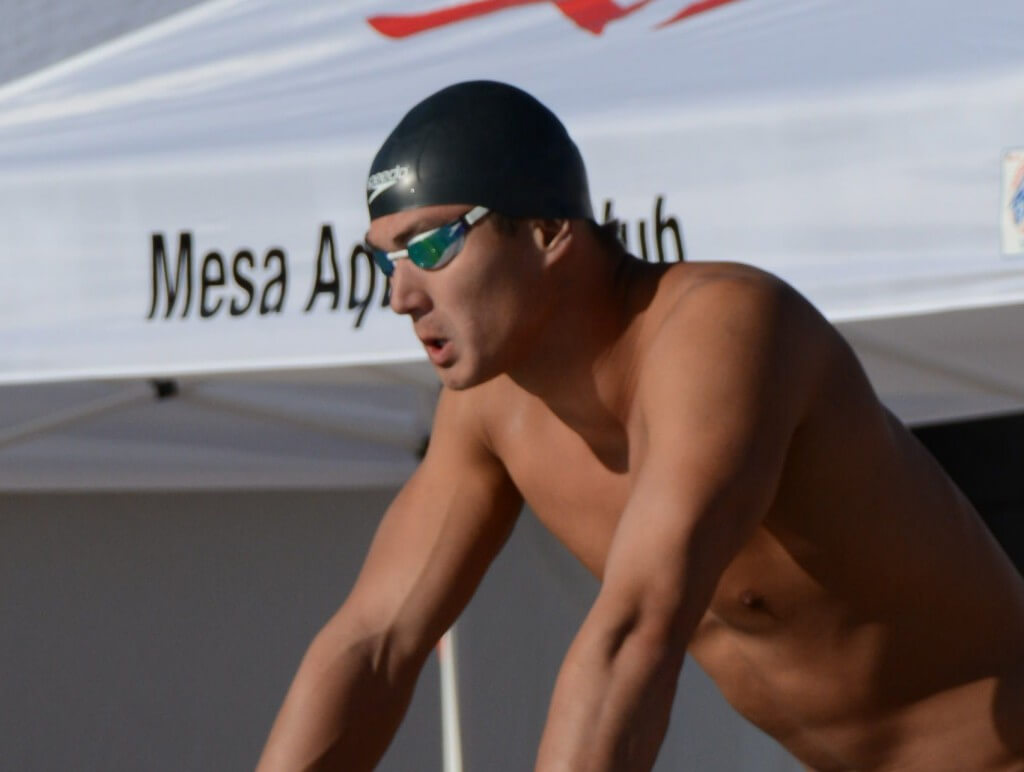Inspiratory Muscle Training: How Can It Help Swimmers?

By Dr. G. John Mullen
SANTA CLARA – Strength training and sports often look for novel avenues of improvement. Unfortunately, these regarded and marketed items frequently disappoint. In the February edition of the Swimming Science Research Review, few novel ideas present themselves for improvement, yet the same old avenues gain more validity:
Inspiratory Muscle Training: Inspiratory muscle training, also known as breathing training, utilizes breathing against a resistance to improve inspiratory muscle strength. Inspiratory muscle fatigue is believed to cause performance decrements, therefore improving inspiratory muscle strength may improve performance. Few teams (that I’m aware of) are using inspiratory muscle training, although I’ve been talking about it for the past two years [see Recapping What We Learned In 2013; Core and Respiratory Dryland Training; All you need to know about inspiratory training part I]. Wilson (2014) recently utilized a inspiratory muscle warm-up in 17 swimmers [this study used British International competitors].
Each swimmer was randomly allocated to one of four different warm-up protocols each week for a period of four consecutive weeks. The primary outcome was a 100-meter freestyle sprint time-trial following warm-up in a 25-meter pool. The study described the protocols as followed:
Protocol 1: Standard swimming warm-up consisting of 2500m (100×25 m lengths), with a mixture of all four strokes (butterfly, backstroke, breaststroke and freestyle), leg only work (kicking with a float), arm-only work (using a pull buoy) and underwater work.
Protocol 2: A respiratory muscle-specific warm-up, using the Powerbreathe inspiratory muscle trainer. A standard protocol was followed consisting of two sets of 30 inspirations at 40 percent of maximal inspiratory muscle pressure. Forty percent load was used to prevent undue fatigue during the warm-up. See below for determination inspiratory pressures.
Protocol 3: Standard swimming warm-up (protocol 1) was performed followed by sham inspiratory muscle training warm-up with a resistance load equal to 15% maximal inspiratory muscle pressure.
Protocol 4: Standard swimming warm-up (protocol 1) followed by the inspiratory muscle training warm-up (protocol 2).
The use of a combined swimming plus inspiratory muscle training (with the Powerbreathe device) warm-up improved 100m swimming performance by 0.62 seconds when compared to a standard swimming warm-up alone and resulted in the fastest swimming time over 100 meters (57.05 seconds). The mechanism for improvement during the inspiratory muscle training trials is not well established, but may help stimulate the mataboreflex and modify centrally controlled fatigue perception.
Overall, the use of inspiratory muscle training warm-up appears beneficial for swimmers.
Resistance Training: Despite the common use, resistance training still bodes mixed results [for more information, read this and this review]. A recent study analyzed the effects of strength training on a Masters swimming population. Gatta (2014) assigned 20 senior male Masters swimmers belonging to the same team to either the strength training (ST, n=10) or swimming training (SW, n= 10) groups. The study lasted six weeks (from September to November in pre-season) and consisted of one session of test (pre- and post-training) before and after one week training sessions. No additional strength, power and/or plyometric training was completed by the subjects out of the training intervention of the present study. Maximal external power was tested after a standardized 800-meter warm-up, then started with swimming at a 10.11 pounds, increasing by 5.6 pounds each trial.
Swimming training was performed five times per week for two hours per session. The strength training consisted of exercise training at 85 percent 1-RM, performing six repetitions as fast as possible, with swimming as the rest period.
Overall, the power increased significantly in the strength training group and not the swimming group. This study has a few flaws:
- The methods were not perfectly clear.
- The outcome variables were swimming power, not actual swimming time.
- It was performed with a small sample.
However, this unique study looked at using swimming as a recovery mechanism between each set of training. Also, after talking with the researchers, they suggest similar results have been found in elite swimmers, but only in a case series (i.e., an extremely low number of participants). Nonetheless, this study confirms similar research suggesting low-volume, high-intensity swimming is likely the best means of improving swimming power and likely swimming performance. However, more research on trained swimmers is warranted.
Summary
Once again, novelty doesn’t always equal great improvements. Sometimes you have to try and stick with things that are being supported in the research. Keep these two items in mind when creating your dryland program and consider trying inspiratory muscle training or using swimming as a recovery from your high-intensity resistance training.
References:
- Wilson EE, McKeever TM, Lobb C, Sherriff T, Gupta L, Hearson G, Martin N, Lindley MR, Shaw DE. Respiratory muscle specific warm-up and elite swimming performance. Br J Sports Med. 2014 May;48(9):789-91. doi: 10.1136/bjsports-2013-092523. Epub 2013 Nov 1.
- Gatta G, Leban B, Paderi M, Padulo J, Migliaccio GM, Pau M. The Development of Swimming Power. Muscles, Ligaments and Tendons Journal 2014; 4(4): 438-445.




Ashley
Juan Yeh
Taylor Snelson
Tony Murphy – you’ll like this
Ollie Hynd
Ollie Hynd
looks just like me before a training session :-
Cauli